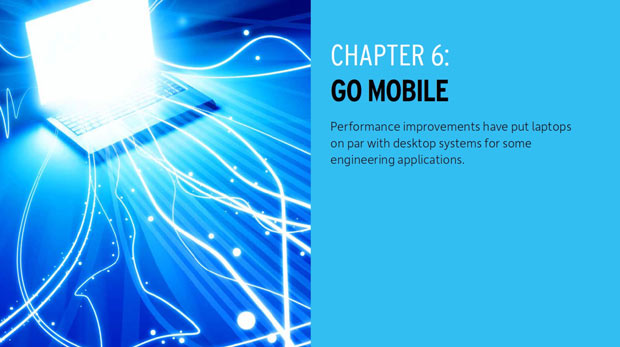Engineers Go Mobile
Latest News
February 23, 2016
 Dear Desktop Engineering Reader:
Dear Desktop Engineering Reader:
For years now, it’s been a barren endeavor when designers check to see if a laptop workstation can really do “my job,” so desktop workstations still rule. But many new technologies now have mobile workstations performing as well as their desktop counterparts for some engineering applications. I emphasize “some engineering applications.” Today’s Check it Out read has what you need to determine if a modern laptop workstation offers you a viable alternative to a desktop-bound computer.
“Go Mobile,” chapter 6 of the Design Engineer’s High-Performance Computing Handbook from Desktop Engineering and Intel, sorts through the technologies as well as the pros and the cons of using a mobile workstation for engineering jobs. In doing so, it performs yeoman’s service for engineers enticed by laptops, IT managers building specs and technical sales reps specializing in engineering computers in two key ways.First, it reviews important technological advances, such as Intel’s new 4-core Xeon CPUs designed for laptops. These CPUs have features like error correcting code (ECC) memory that bring mobiles on par with Xeon chips for desktop workstations. As well, new laptop graphics processors and storage systems can now provide engineers real productivity gains.
But the chapter also explains the limitations of mobiles and where desktop workstations hold the performance edge. For example, currently, four cores and 64GB of memory max out laptop workstations. That’ll handle a lot of engineering applications. But if you’re into modeling, rendering or analysis, you might need more cores, memory and graphics computing capacity than you can cram into a laptop form factor.
Second, chapter 6 offers guidance on how to select a mobile workstation. This is where it shines. “Go Mobile” is filled with easily forgotten yet common-sense advice such as don’t cheap out buying a business laptop and big screens are heavier than small ones. Most importantly, it stresses that you must understand your workflow, your applications and what size files you work with or you could be frustrated with your mobile selection.
 “Go Mobile,” chapter 6 of The Design Engineer’s High-Performance Computing Handbook from Desktop Engineering in partnership with Intel, explains what design engineers need to know before committing to a mobile engineering workstation as a desktop alternative.
“Go Mobile,” chapter 6 of The Design Engineer’s High-Performance Computing Handbook from Desktop Engineering in partnership with Intel, explains what design engineers need to know before committing to a mobile engineering workstation as a desktop alternative.The gist of “Go Mobile” is that selecting a mobile engineering workstation can be tricky business. Mobiles handle many engineering jobs as well as a desktop but, to select your mobile engineering workstation well, you have to know what you’re doing. Chapter 6 can help you make the right choice. Hit today’s Check it Out link to download your complimentary copy.
Thanks, Pal. – Lockwood
Anthony J. Lockwood
Editor at Large, Desktop Engineering
Subscribe to our FREE magazine, FREE email newsletters or both!
Latest News
About the Author
Anthony J. Lockwood is Digital Engineering’s founding editor. He is now retired. Contact him via [email protected].
Follow DE





